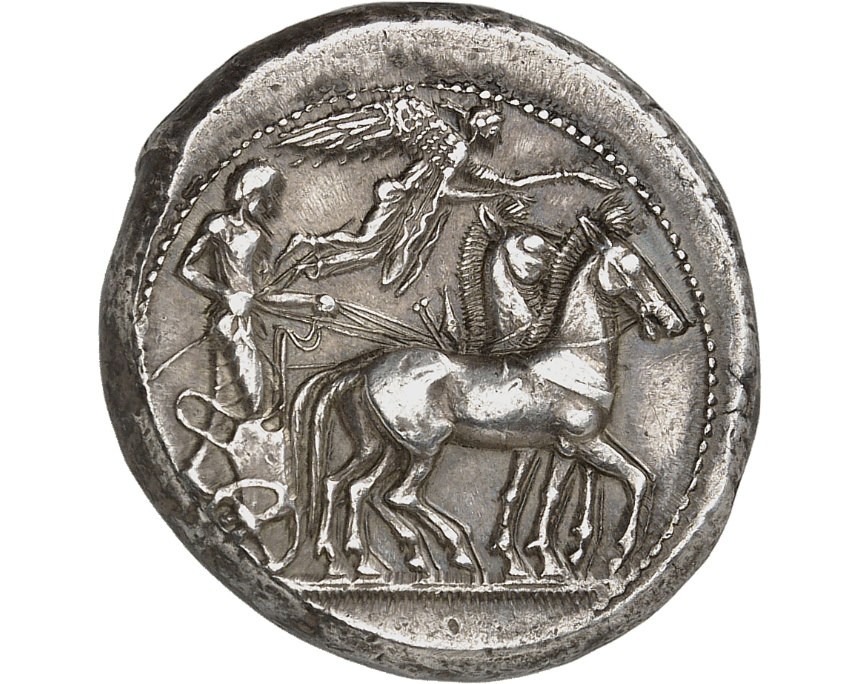The Top Results of Künker’s Auction 416 of Coins from the Ancient World
Künker
Auction 416
Coins
29-30 October 2024
D-Osnabrück
Künker’s auction 416 contained 1038 lots with select Greek, Celtic, Roman and Byzantine coins from various possessions. The auction was kicked off by the collection of Dr. Eike Druckrey, who summarized his ensemble under the title “The Aesthetics and the World of Thought of the Early Greeks”. This article presents the most expensive pieces of the auction sale, distinguishing between the results of the Dr. Eike Druckrey Collection and pieces from other possessions.
The Dr. Eike Druckrey Collection
305 Greek coins were part of the Dr. Eike Druckrey Collection, including many pieces of exquisite style, perfect quality and far-reaching provenances. Therefore, it did not come as a surprise that the bidders were falling over themselves to get their hands on these pieces. After all, you can rarely find coins on the market that were once part of the great collections of Charles Gillet (“Kunstfreund”) or Moretti. The results were correspondingly impressive.
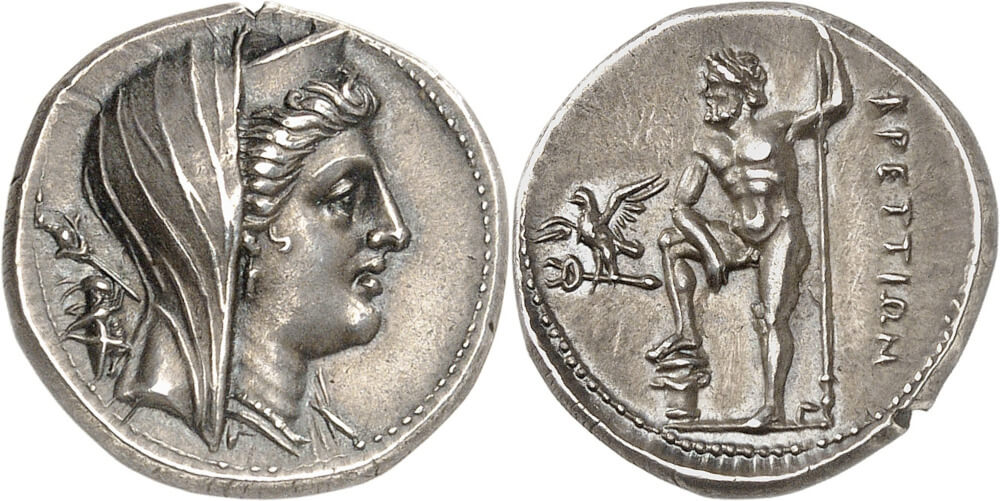
No. 1021. Brettii / Bruttium. Drachm, 215-205. From Feuardent auction (1919), No. 50; from the Moretti Coll., NAC auction 13 (1998), No. 184. About extremely fine. Hammer price: 36,000 euros.
Top 5
36,000 euros for a drachm of the Brettii is an impressive result. But if you keep in mind that this coin is one of the most beautiful – if not the most beautiful – specimen of this rather rare issue, it becomes easier to understand why it fetched such a high hammer price. The coin is from the Moretti Collection, which was on display for decades at the Basel Museum of Ancient Art. The catalog produced at the time – co-authored by numismatic legends such as Herberg Cahn, Leo Mildenberg, Roberto Russo and Hans Voegtli – is still a must read for any collector of coins from Magna Graecia and Sicily. The issues itself take us back into the midst of Hannibal’s war against the Romans: the Brettii, Hannibal’s allies, used the drachms, which were probably made from Carthaginian silver, to pay the mercenaries who were supposed to defend them against Roman legionaries.
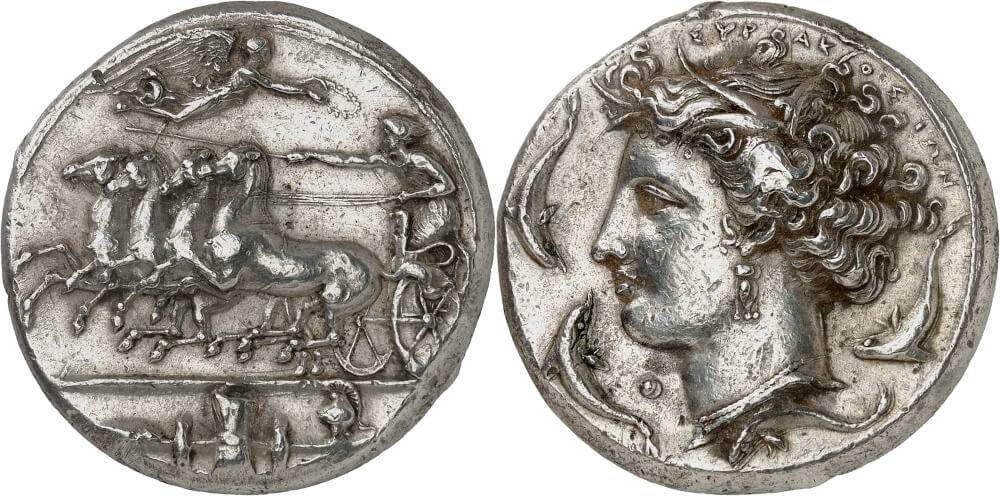
No. 1073. Syracuse / Sicily. Decadrachm, 400-370. From Leu auction 71 (1997), No. 81. Hammer price: 38,000 euros.
Top 4
Decadrachms from Syracuse are the most prized possession of any collector of Greek coins. Dr. Eike Druckrey owned such a specimen. It fetched a hammer price of 38,000 euros.
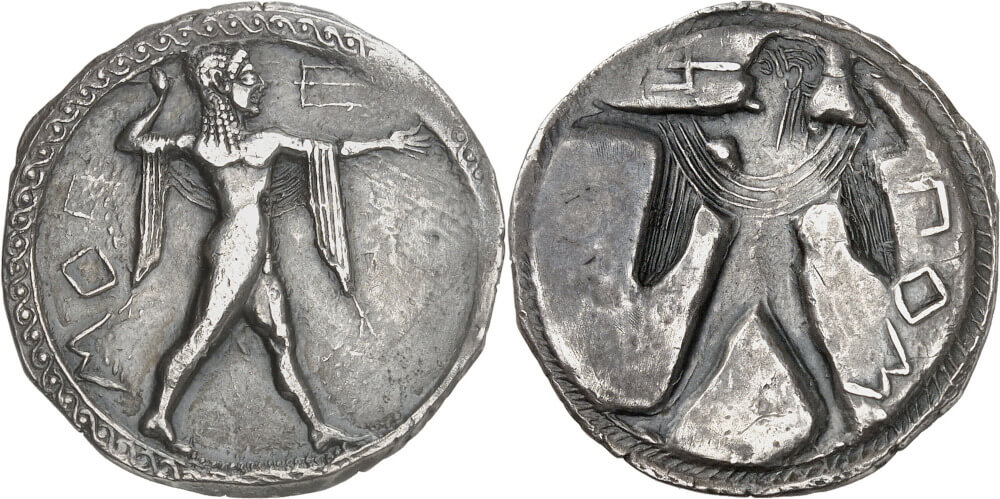
No. 1015. Poseidonia / Lucania. Stater, 530-500. From the Gillet Collection, Leu auction 77 (2000), No. 51. Hammer price: 40,000 euros.
Top 3
The incuse stater from Poseidonia, purchased by Dr. Eike Druckrey in 2000, is from the Charles Gillet (“Kunstfreund”) Collection. The collector must have been delighted with his purchase, for the trident-throwing Poseidon is the most popular type in a particularly exciting series from archaic Magna Graecia. At the time, a number of cities in southern Italy issued staters with a similar design: one side with a normal municipal motif, the other side with the incuse motif surrounded by a border of lines. The new owner was willing to pay 40,000 euros for his Poseidon issue. He too is likely to be delighted with this coin, which combines everything that coin collectors appreciate – beauty, rarity and exceptional provenance.
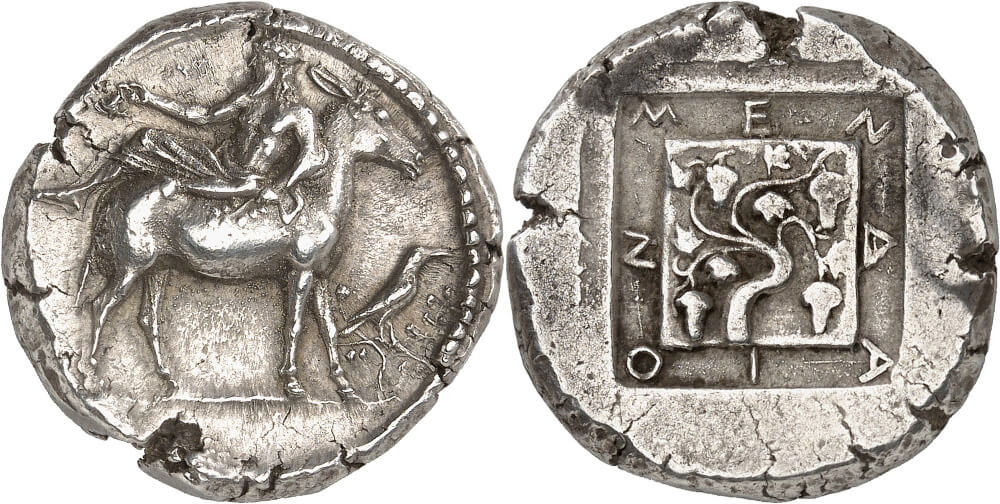
No. 1133. Mende / Macedonia. Tetradrachm, 460-423. From Hess-Leu auction 15 (1960), No. 131. Extremely fine / Very fine. Hammer price: 42,000 euros.
Top 2
The provenance of the fantastic tetradrachm from Mende dates back to 1960, although in this case it was not so much the provenance as the excellent condition of the piece that led to its hammer price of 42,000 euros. After all, there are only a handful of truly superb specimens of this popular series depicting Dionysus backwards on his donkey. The obverse of the specimen from the Dr. Eike Druckrey Collection was extremely fine; so much so that the individual leaves of Dionysus’ ivy branch at the highest point of the donkey’s back are recognizable.
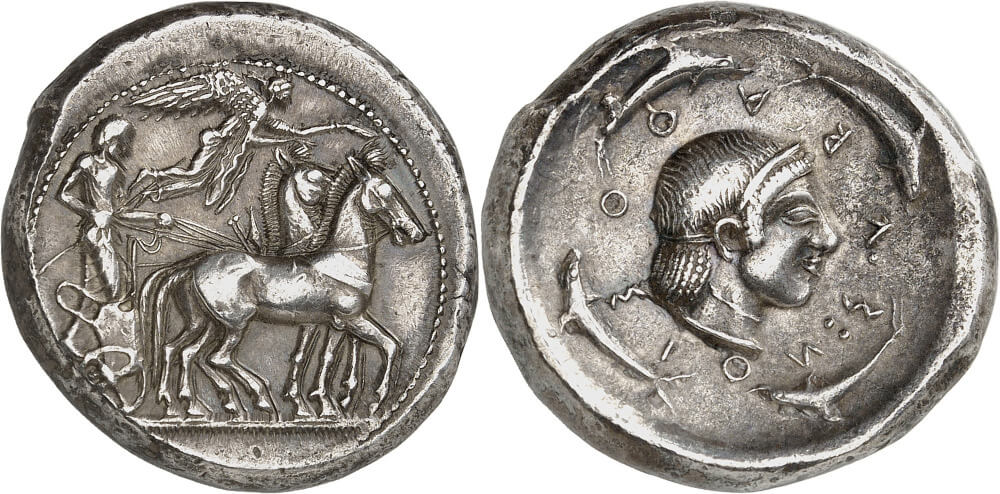
No. 1060. Syracuse / Sicily. Tetradrachm, 485-480. Purchased on 10 November 1997. Rare. Extremely fine / About extremely fine. Hammer price: 50,000 euros.
Top 1
With a hammer price of 50,000 euros, there is no doubt about the most expensive coin in the Dr. Eike Druckrey Collection: it is a tetradrachm from Syracuse, created neither in the early archaic period nor in the era of signing artists, but at some time in between. The piece of exceptional quality with verified purchase on 10 November 1997 stands out due to its fresh obverse die. Anyone who is familiar with Syracusan coinage knows how rare it is to come across a coin with a sharply minted obverse. The Syracusans usually used their dies until the obverse die was completely worn out. The piece in the Dr. Eike Druckrey Collection is different: every detail of the victorious quadriga is visible, every feather on Nike’s wing, every crease in the charioteer’s robe. Collectors immediately realized what an extraordinary coin they were looking at. Bids soared until the hammer fell at 50,000 euros.
Coins from the Ancient World
Greek coins are something for connoisseurs who are fascinated by beautiful aesthetics, for all those who pay more attention to masterful die-cutting than to a coin’s historical context, as we usually only have a vague idea of the background of Greek coins. However, when it comes to the field of ancient coins , most collectors decide to focus on these pieces because of their interest in history. They love Roman numismatics because we know many of the historical figures that are depicted on Roman coins from our Latin class in school. Internationally, there is a much larger group of collectors of Roman coins than of Greek coinage. Therefore, especially aurei usually realize significantly higher prices than even the most beautiful Greek coins.
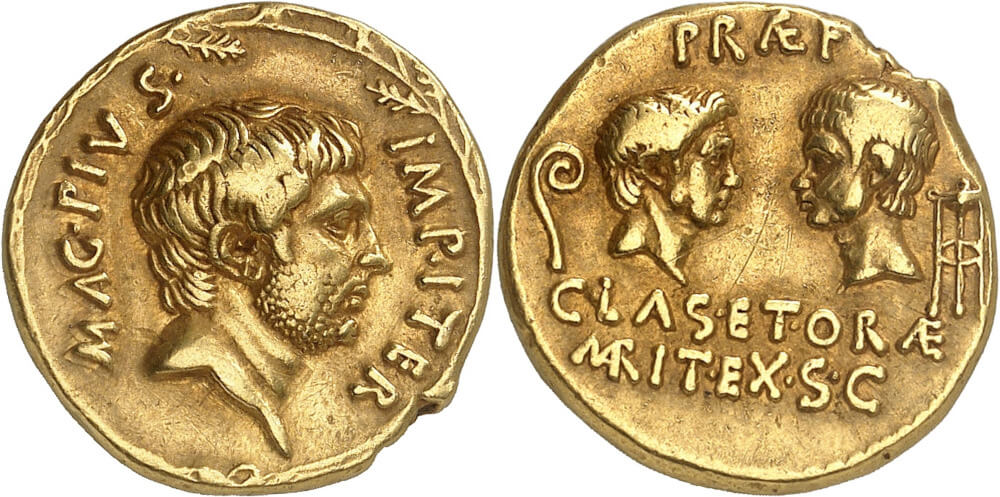
No. 1822. Sextus Pompeius. Aureus, 37/6 BC, Sicilian mint. Very rare. Very fine. Hammer price: 75,000 euros.
Top 5
So let us move on to 5th place of Künker’s catalog 416. The result of this coin – 75,000 euros – already is 1.5 times the hammer price of the most expensive piece in the Dr. Eike Druckrey Collection. It is an extremely rare aureus of Sextus Pompeius, featuring the portrait of his father and his brother on the reverse. This coin was probably connected to the fleet that Pompeius built in preparation for the final confrontation with Octavianus and his brilliant general Agrippa.
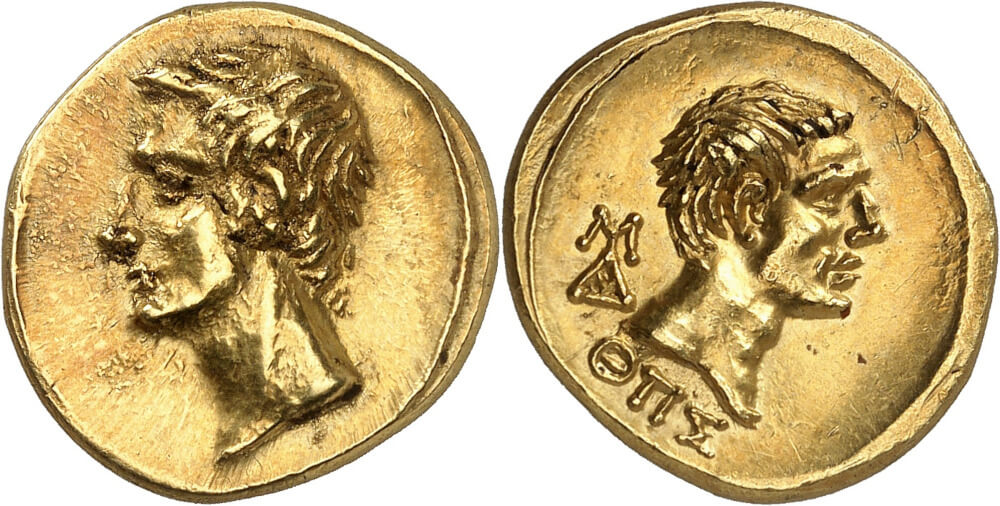
No. 1868. Polemon I / Bosporus. Augustus and Agrippa. Stater, year 289 (= 9/8 BC). From the collection of Grand Duke Alexander Mikhailovich Romanov, Christie, Manson & Woods auction (1984), No. 233. Hammer price: 75,000 euros.
Top 4
In 4th place, we have another coin with a hammer price of 75,000 euros. Since it had an estimate of 60,000 euros, it experienced a more significant increase in price than the previous specimen, which is why we put it in 4th place. The gold stater depicts the dream team that defeated Sextus Pompeius: Augustus and Agrippa. The coin was commissioned by a Hellenistic ruler called Polemon I, whose empire stretched along the Bosporus. He dedicated his issue of the year 289 (= 9/8 BC) to the world ruler Augustus and his son-in-law Agrippa, who had already died at the time. The coin is from the collection of Grand Duke Alexander Mikhailovich Romanov, so it has an exquisite provenance.
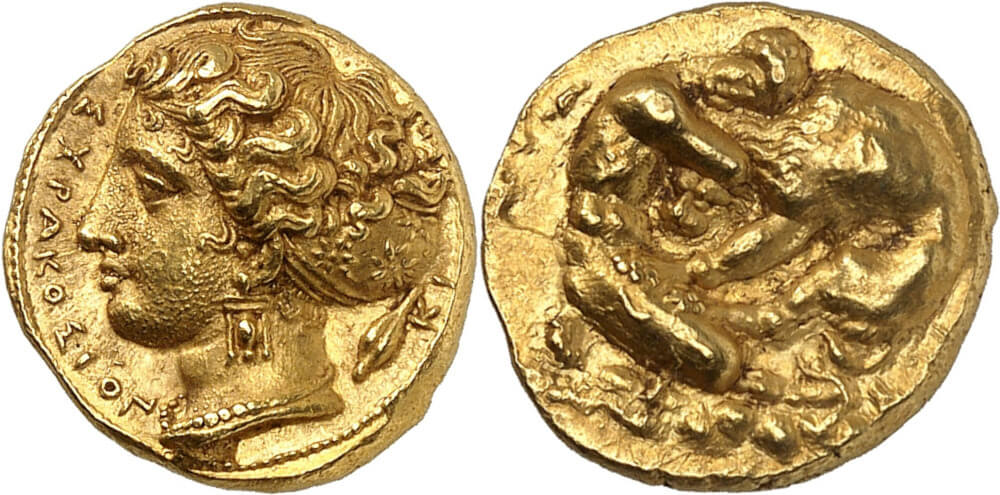
No. 1561. Syracuse / Sicily. 100 litrae, 405-400. Obv. signed by Kimon. From the collection of a North German friend of antiquity. From the R. Jameson Collection. Very rare. Extremely fine. Hammer price: 80,000 euros.
Top 3
Surprisingly, the 3rd most expensive coin in Künker’s auction 416 is a Greek coin after all. It is from the collection of a North German friend of antiquity and is the famous exception that proves the rule. What is so special about this piece is its great rarity – even though you have to look very closely to identify it. For it is not one of the usual 100-litrae pieces of Syracuse. Instead, the artist Kimon himself created the dies for this piece. Experts consider Kimon to be the best engraver of Syracuse, and his coin designs had a lasting influence on generations of engravers. So there is a good reason why a connoisseur and lover of beautiful coins was willing to pay 80,000 euros for this piece.
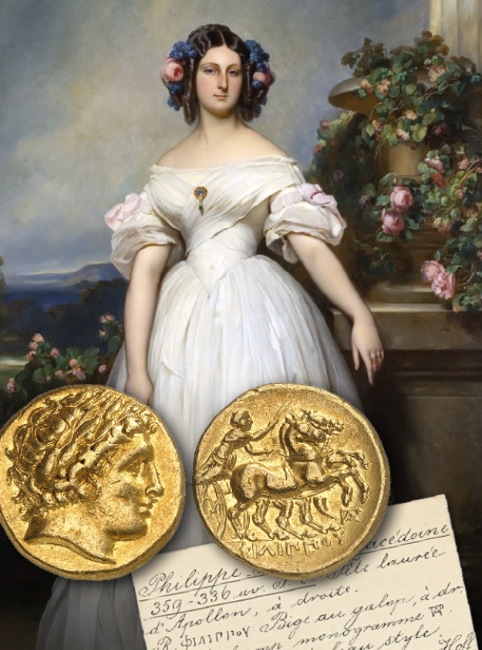
No. 2166. Collection of Clémentine d’Orléans, Duchess of Saxe-Coburg-Koháry with 306 ancient coins. Hammer price: 95,000 euros.
Top 2
306 ancient coins from the estate of Clémentine d’Orléans, Duchess of Saxe-Coburg-Koháry were offered as a multiple lot in Künker’s auction 416. It is of great historical significance, not because of individual pieces, but because of the overall picture of this ensemble as a whole. The collection commemorates a remarkable woman who enjoyed a modern upbringing as the daughter of the French Citizen King Louis Philippe, and who reshaped the fate of Europe as a mature woman. When she grew old, she spent her time collecting coins. She was particularly interested in Byzantine numismatics. She identified the coins herself and wrote the specifications on small envelopes. A coin enthusiast was prepared to pay 95,000 euros for this ensemble. He thus acquired a high-caliber testimony to the history of coin collecting.
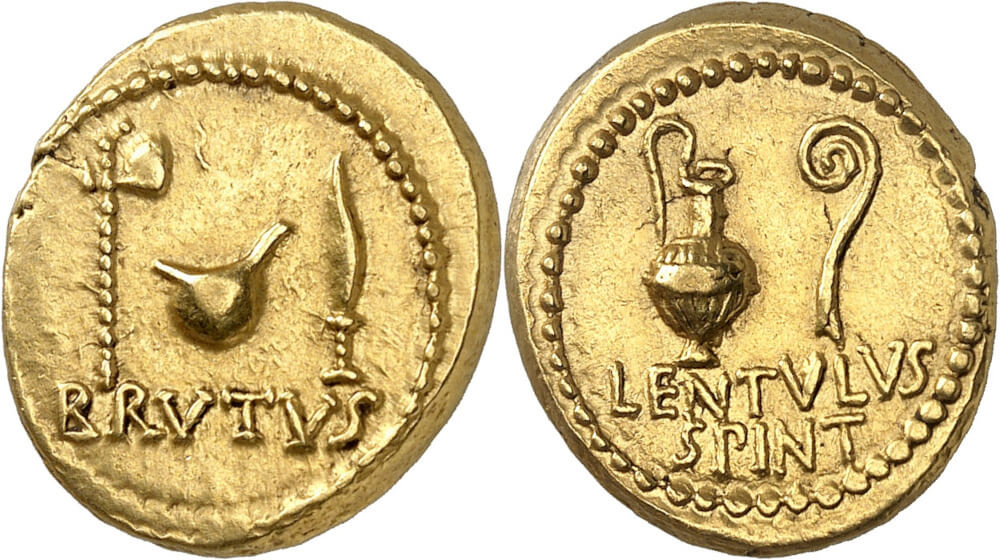
No. 1809. M. Iunius Brutus. Aureus, 42 BC, Asia Minor mint. Purchased on 12 September 1969 at Spink & Son, London. Very rare. About extremely fine. Hammer price: 170,000 euros.
Top 1
Finally, we get to the most expensive coin of auction 416 and the most expensive coin of the entire second part of Künker’s Fall Auction Sales. 170,000 euros was the hammer price for a Brutus aureus, probably minted from looted gold after the conquest of Rhodes to finance the army of Caesar’s assassins. Coins of Brutus have become the Holy Grail of Roman numismatics, even if they do not feature his portrait. It was therefore to be expected that this coin would far exceed its estimate of 100,000 euros, especially as its provenance can be traced back to 1969.
It cannot be said too often: although Künker naturally highlights spectacular and expensive lots in its auction reviews, coin collecting is a hobby that does not require much money to be thoroughly enjoyed. We want to prove this with the results of Künker’s eLive Premium Auction 417. It contained part 9 of the Dr.W.R. Collection with coins from the era of the civil wars following Nero’s death up to the Severan dynasty. To find out more, read on in the review of Künker’s auction 417.
You can find all auction results online at www.kuenker.de/en. If you have any questions, please do not hesitate to contact Künker, Nobbenburger Str. 4a, 49076 Osnabrück; phone: +49 541 / 962020; fax: +49 541 / 9620222; or via e-mail.







